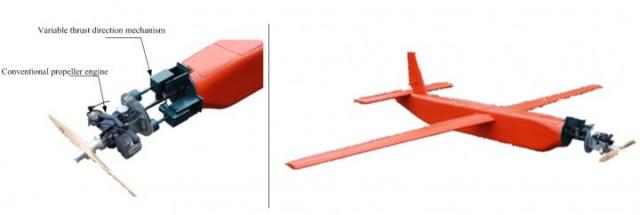Dec 31 2015
The unmanned aerial vehicles (UAV) designed for plateau missions are usually installed with high span chord ratio wings, which provides more lifting force at a relatively low airspeed.
 The proposed variable thrust direction mechanism is shown in Fig.1, a conventional propeller engine is mounted on a two dimensional rotate disk, which is driven by two servo actuators. By combining the linear motions of the actuator, both the azimuth and the altitude angle of the disk with respect to the fuselage can be controlled, and thus changing the thrust direction of the propeller. Credit: ©Science China Press
The proposed variable thrust direction mechanism is shown in Fig.1, a conventional propeller engine is mounted on a two dimensional rotate disk, which is driven by two servo actuators. By combining the linear motions of the actuator, both the azimuth and the altitude angle of the disk with respect to the fuselage can be controlled, and thus changing the thrust direction of the propeller. Credit: ©Science China Press
The UAVs employ high span chord ratio wings, however, tend to lose their maneuverability. Hence, they usually need larger turning radius and unable to maintain the altitude during sharp slope turning as the lifting force produced by the wings decrease dramatically when the bank angle is large. The discarding of the flight performances may risk the safety of the flight in plateau mountain regions. Variable thrust direction (VTD) technology is a type of thrust vectoring control (TVC) approach that allows to manipulate the directions of thrust to the fuselage of the aircraft.
Most of the existing works are designed for jet engines, which cannot be applied to the conventional propeller engine aircraft. In a paper published in SCIENCE CHINA Information Sciences recently, researchers develop a novel VTD mechanism to the conventional propeller engine UAV, which allows redirecting parts portion of the thrust from the propeller engine to other directions rather than normal axial direction. A combination flight controller for the VTD enhanced UAV is then proposed to coordinate the VTD controlled forces and aerodynamic surfaces forces.
The proposed variable thrust direction mechanism is shown in Fig.1, a conventional propeller engine is mounted on a two dimensional rotate disk, which is driven by two servo actuators. By combining the linear motions of the actuator, both the azimuth and the altitude angle of the disk with respect to the fuselage can be controlled, and thus changing the thrust direction of the propeller.
By the introduction of the VTD capability to the conventional propeller UAV, the maneuverability of the UAV has been greatly enhanced, since the VTD engine enables direct force control of the aircraft. The newly developed VTD UAV was applied to implement plateau missions, which demonstrates the usefulness of the proposed technique.